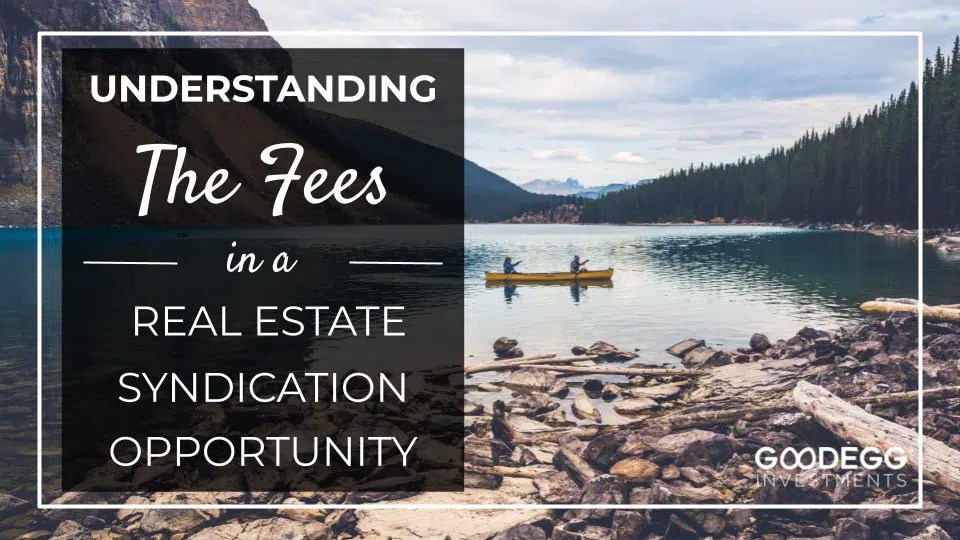If you’ve ever bought a home or purchased a car, you know the mind-boggling amount of fine print and fee disclosures you’re required to wade through and agree to. Well, when it comes to investments, there are fees as well – that’s how the people who research and manage the investment get paid and an integral part of why and how the opportunity is available to you.
We all know there are fees associated with any significant transaction, but it’s nice to know what they’re for and how they affect you and your investment partners instead of feeling like the fees or those responsible for them are “out to get you.”
In this article, we’ll explore the eight most common fees you’ll see in a commercial real estate syndication and walk through what each one means, how much it may be, and what you, as a passive investor, want to watch out for when examining an investment opportunity.
Debunking The Biggest Myths Investors Have About Real Estate Syndication Deals
Let’s start from the top in our comprehensive fee explanation journey and talk about some of the top myths investors believe when it comes to real estate syndications.
Myth #1 – You Have No Control
First up, you may believe that all control over your capital is relinquished when you invest in a commercial real estate syndication. However, this is far from the case because while you may not be setting the timer for the sprinklers or have a direct hand in choosing kitchen finishes, you have 100% say in what type of asset you invest, the asset class, the capital amount, which deal with which sponsor, whether you choose a value-add deal or not, and so much more.
Syndications allow investors a front-loaded level of control so that once a syndication deal is chosen and funds are wired, you can use the precious time you have to do what you want with those you love.
Myth #2 – You’ll Get A Lower Return
Second, it’s been purported that you’ll get a lower return investing in syndications, although real estate historically outperforms the stock market. No matter what type of investment you’re exploring, make sure you’re comparing “apples to apples.” Don’t make the mistake of comparing gross returns to net returns. That could be very misleading because gross returns are the profits or earnings before any fees are taken out, while net returns reflect what you’ll actually take home.
When exploring and comparing commercial real estate syndication deals, yes, there are always fees, but there are three things to consider as you sort through them:
- Are the fees creating alignment between the investment and asset goals of the general and limited partners and driving performance?
- Can you still make a reasonable (projected) return on your capital that propels you toward your goals?
- Are the sponsors transparent about the fees being charged and what they’re for?
No one likes hidden or surprise fees, so when the general partnership is being transparent, the fees listed are reasonable, and you still make money; that’s a win!
If you’re like me, you don’t have the time or mental energy for fee gymnastics. So instead, ensure that your investment choice is based on the projected net returns across the board. That is, you want to be comparing investment opportunities’ returns after fees have already been removed. Hence, you have clarity on how that passive income might affect your budget and your goals.
Eight Of The Most Common Fees You Might See On A Real Estate Syndication Investment
To further debunk myth #2 up there, it’s essential to understand why the fees you see listed on a deal exist and what their purpose is. From there, you can more deeply understand the mechanics of a real estate syndication and more confidently peruse through the business plan, PPM (private placement memorandum), and decide definitively if a deal aligns with your goals or not.
So, let’s hold hands and walk through each of these. Shall we?
Acquisition Fee – This is typically 1-3% of the purchase price of the asset and covers costs associated with the resources and due diligence performed by the sponsor to acquire the asset.
Sometimes sponsors spend weeks or even months researching and underwriting deal after deal to no avail. The acquisition fee is what keeps the lights on, so to speak, and helps afford all that effort during and between deals.
Asset Management Fee – At about 1-2% of either the projected gross income or the capital invested (sponsor’s preference), this money pays for the ongoing bookkeeping, coordination, and communication that’s required to manage the asset and execute on the business plan properly.
Construction Management Fee – On value-add or development deals, a construction management fee of about 5-10% of the expected construction budget is necessary for managing the renovations on the property. Attentive, thorough oversight is required to ensure construction projects finish on time and within budget.
Equity Placement Fee – A fee charged upfront by the broker that covers the cost of obtaining investors, limited partners (like you!), and the marketing, coordination, and behind-the-scenes communication and paperwork. Also sometimes called the equity origination fee, this is usually around 1-2% of the capital invested.
Loan Fee – This fee compensates the sponsor for their work toward obtaining financing because getting a loan of this size takes immense effort. A loan fee is typically 1% of the total loan amount.
Guarantor Fee – Occasionally, loans require a key partner to pledge assets to guarantee the loan personally. Typically between 1-2% of the loan amount compensates the guarantor for their pledge and support.
Refinance Fee – At about 1-2% of the refinanced loan amount, this fee, also called a capital event, compensates critical parties for the time and energy required to refinance the property. If you’ve ever received a portion of your investment capital back and experienced the joy of cash-on-cash returns as if all your money was still invested, you’ll probably agree that the refinance fee is well worth it!
Disposition Fee – Finally, a disposition fee is often charged to cover marketing costs and selling the asset once the business plan has been executed. 1-2% of the sales price of the asset ensures a smooth transition from your syndication ownership to the next party.
Becoming A Fee-Savvy Passive Investor
Now that you know what each fee is for and approximately how much it might be, you need to understand that each sponsor may charge varying fees (in number and by percentage) depending upon their values.
Here at Goodegg, one of our guiding values is transparency. So when we publish a proforma, the projected returns are net of fees. It’s important to us that documents are easy for our investors to understand and evaluate.
Typically the cash-on-cash returns (quarterly disbursements) and IRR projections are net of the acquisition fee, asset management fee, disposition fee, and, if applicable, a refinance and guarantor fee. We know it’s important to you to have fewer fees, so it’s important to us too, and you usually won’t see more than about four fees on our commercial real estate syndication deals.
As part of your journey in getting started as a passive investor, learning about and understanding the fee structure is one more checkbox checked toward being ready to grab a seat in our next deal. If you haven’t already, make sure you join the Goodegg Investor Club today so you can begin browsing opportunities!





